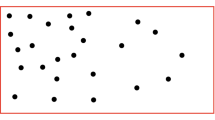Abstract
We discuss some problems which arise if one tries to implement renormalization group transformations as maps from Hamiltonians to Hamiltonians. We provide various examples, involving systems not necessarily in the vicinity of a phase transition, where this can not be done, because Gibbs measures under the action of various real-space transformations become non-Gibbsian. We mention some related issues occurring in non-equilibrium problems.
Speaker at the conference
Access this chapter
Tax calculation will be finalised at checkout
Purchases are for personal use only
Preview
Unable to display preview. Download preview PDF.
Similar content being viewed by others
References
A.C.D. van Enter, R. Fernandez and A.D. Sokal, Regularity properties and pathologies of position-space renormalization-group transformations: Scope and Limitations of Gibbsian the ory, J. Stat. Phys. ,72, 879 (1993).
N. Goldenfeld, “Lectures on Phase Transitions and the Renormalization Group”, Addison- Wesley, Frontiers in Physics 85 (1992).
H.-O. Georgii, “Gibbs Measures and Phase Transitions”, Walter de Gruyter, De Gruyter Studies in Mathematics 9 (1988).
R.B. Griffiths and D. Ruelle, Strict convexity (“continuity”) of the pressure in lattice systems, Comm. Math. Phys. ,23, 169 (1971).
W.G. Sullivan, Potentials for almost Markovian random fields, Comm. Math. Phys. ,33, 61 (1973).
O.K. Kozlov, Gibbs description of a system of random variables, Prob. Inform. Transmission ,10, 258 (1974).
R.B. Griffiths and P.A. Pearce, Position-space renormalization-group transformations: Some proofs and some problems, Phys. Rev. Lett. ,41, 917 (1978).
R.B. Griffiths and P.A. Pearce, Mathematical properties of position-space renormalization-group transformations, J. Stat. Phys. ,20, 499 (1979).
R.B. Israel, Banach algebras and Kadanoff transformations, in: “Random Fields (Esztergom 1979)” II, 593, North-Holland (1981).
I.A. Kashapov, Justification of the renormalization-group method, Theor. Math. Phys. ,42, 184 (1980).
C. Cammarota, The large block spin interaction, Nuovo Cim. B ,96, 1 (1986).
F. Martinelli and E. Olivieri, Some remarks on pathologies of renormalization group transfor mations for the Ising model, J. Stat. Phys. ,72 (1993).
A.C.D. van Enter, R. Fernandez and R. Kotecký, in preparation.
R.L. Dobrushin and S.B. Shlosman, Completely analytical interactions: Constructive descrip tion, J. Stat. Phys. ,46, 983 (1987).
L.N. Tolstoy, “Anna Karenina”, translated by A. and L. Maude, Everyman–s Library, Knopf (1992).
G. Orwell, “Animal Farm”, Secker & Warburg (1945).
R.B. Israel, private communication.
T. Kennedy, Some rigorous results on majority rule renormalization group transformations near the critical point, J. Stat. Phys. ,72, 15 (1993).
R.H. Schonmann, Projections of Gibbs measures may be non-Gibbsian, Comm. Math. Phys. ,124, 1 (1989).
C. Maes and K. Vande Velde, The (non-)Gibbsian nature of states invariant under stochastic transformations, Leuven preprint (1993).
R. Fernandez and C.-E. Pfister, in preparation.
P. Holický and M. Zahradník, On entropic repulsion in low temperature Ising models, in: “Proceedings of the NATO Advances Studies Institute Workshop on Cellular Automata and Cooperative Systems (Les Houches (1992))”, 275 Kluwer (1993).
J. Fröhlich and C.-E. Pfister, Semi-infinite Ising model I, Comm. Math. Phys. ,109, 493 (1987).
J. Fröhlich and C.-E. Pfister, Semi-infinite Ising model II, Comm. Math. Phys. ,112, 51 (1987).
S. Albeverio and B. Zegarlinski, Global Markov property in quantum field theory and statis tical mechanics: A review on results and problems in: “Ideas and Methods in Quantum and Statistical Physics”, 331, Cambridge University Press (1992).
T.M. Liggett, “Interacting Particle Systems”, Springer (1985).
J.L. Lebowitz and R.H. Schonmann, Pseudo-free energies and large deviations for non-Gibbsian FKG measures, Prob. Th. Rel. Fields ,77, 49 (1988).
J.L. Lebowitz, C. Maes and E.R. Speer, Statistical mechanics of cellular automata, J. Stat. Phys. ,59, 117 (1990).
F. Martinelli and E. Scoppola, A simple stochastic cluster dynamics: Rigorous results, J. Phys. A ,24, 3135 (1991).
K. Vande Velde kindly informed us that both he and E.R. Speer have proven the non-Gibbsianness of the stationary states of the totally asymmetric exclusion process.
C.-E. Pfister, Large deviations and phase separation in the two-dimensional Ising model, Helv. Phys. Act ,64, 953.
D. Ioffe, Large deviations for the 2D Ising model, Courant Institute preprint (1993). We thank Chuck Newman for informing us about this work and providing us with a preprint
J. Lörinczi, these proceedings.
J. Lörinczi and M. Winnink, Some remarks on Almost Gibbs states, in: “Proceedings of the NATO Advanced Studies Institute Workshop on Cellular Automata and Cooperative Systems (Les Houches (1992))”, 423, Kluwer (1993).
A.C.D. van Enter, R. Fernandez and A.D. Sokal, Renormalization transformations as a source of examples and problems in probability and statistics, Proceedings of V CLAPEM, Sao Paulo (1993), to appear.
Author information
Authors and Affiliations
Editor information
Editors and Affiliations
Rights and permissions
Copyright information
© 1994 Springer Science+Business Media New York
About this chapter
Cite this chapter
van Enter, A.C.D., Fernández, R., Sokal, A.D. (1994). Gibbsian versus Non-Gibbsian Measures: Some Results and Some Questions in Renormalization Group Theory and Stochastic Dynamics. In: Fannes, M., Maes, C., Verbeure, A. (eds) On Three Levels. NATO ASI Series, vol 324. Springer, Boston, MA. https://doi.org/10.1007/978-1-4615-2460-1_15
Download citation
DOI: https://doi.org/10.1007/978-1-4615-2460-1_15
Publisher Name: Springer, Boston, MA
Print ISBN: 978-1-4613-6047-6
Online ISBN: 978-1-4615-2460-1
eBook Packages: Springer Book Archive




